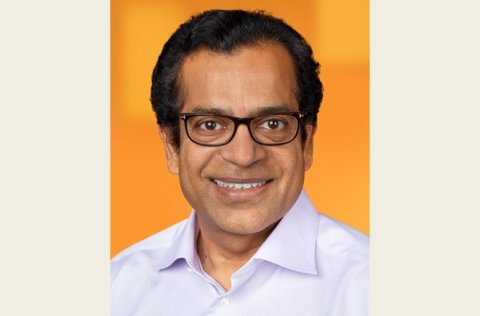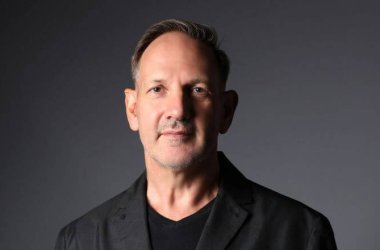CNME Editor Mark Forker speaks to SolarWinds CEO Sudhakar Ramakrishna, on his leadership style, the challenge of staying relevant, removing complexity, its purpose to enrich the lives of its customers – and the importance of humility in the face of adversity. 
SolarWinds CEO Sudhakar Ramakrishna is a global technology leader with over 25 years of experience in cloud, mobility, networking and security.
In a stellar career Ramakrishna has held senior roles at Motorola, Polycom and Citrix, and was the CEO of Pulse Secure.
He was appointed as SolarWinds CEO in January 2021 – and under his tutelage the software leader has bounced back from one of the most high-profile cyberattacks in history, to be one of the most secure software companies in the world.
Ramakrishna has drawn acclaim from industry peers for the outstanding leadership he has shown since taking the reign at SolarWinds – but how would he describe his own leadership style?
“I like to think of my leadership in two ways. Firstly, I am a situational leader, which essentially means you focus on what needs to be done. Secondly, I am a participative leader, which means it is not about you – it’s about the entire team, organisation and community. Participative leadership is all about trying to get best out of everyone. I often say to my team that they should never worry about what they want to do, but instead worry about what needs to be done. As a leader it is always important to be conscious of what needs to get done, which is the situational part – and you want to do it with, and through people and that’s the participative part, and that’s how I would largely describe my leadership style,” said Ramakrishna.
Ramakrishna also added that not taking yourself too seriously and humility were other hugely important components required in a good leader.
“It’s important to acknowledge that whilst you are running a very serious business, it’s important not to take yourself too seriously, and that’s the balance I’ve been trying to strike. I can be incredibly stubborn and rigid as well, because there are sometimes when you just don’t have the time, instances where you may have been thrown into a crisis and you just have to respond. There are times when there is no time for deliberations and you have to trust your gut. That’s also where humility comes into play, because as confident as you may be about what you are doing, you also have to keep listening to see where your blind-spots are,” said Ramakrishna.
SolarWinds serve 300,000 customers globally, and continually retain over 90% of them on an annual basis.
They are a hugely successful company, but with that success comes great responsibility – and the SolarWinds CEO highlighted the need to remain relevant in a constantly evolving digital economy.
“The customer base we have provides us with a great foundation, but as you can imagine the trust that they place in us also creates a great obligation for us to address their needs in today’s digital economy, and in the future. People often ask me what keeps me up at night? In my role as CEO, I worry about two things, one is how do we stay relevant in the future – and how do we scale as a team and as a company? When I say how do we stay relevant, what I essentially mean is, how do we serve the customer today, and anticipate their needs in the future – and build things that supports them and helps them succeed going forward? The scale part is internal, do you have the right people, skills, systems and tools and so on,” said Ramakrishna.
Ramakrishna says it is evident that digital transformation will continue to accelerate across all industry verticals globally – but added that complexity is also growing at speed.
“You can now say that every business is a software business at some level, because in today’s climate we are all using software. However, you can also see that complexity is growing rapidly in every business, due to cloud and other applications – and whilst budgets are increasing, they are not increasing in tandem with the complexity that they have to deal with,” said Ramakrishna.
Ramakrishna said that from a vendor perspective the question is what are you going to do about it?
The SolarWinds CEO wrote a position paper internally for the company, which explained how they were going to go through this evolution.
“SolarWinds has a rich history of building simple solutions, but the simple solutions were predominantly focused around tools. The challenge from an innovation standpoint is can you address the complexity of this new age simply? The other challenge was how do we help customers derive better value and focus on their value proposition. We said we were going to be the company that delivers the best time-to-value for our customer, often what happens is businesses buy enterprise software, and it could take anywhere from 6-18 months before they see a return from it. We don’t want to put our customers through that – and that’s why we have an internal metric that says 90% of our customers that buy our software should get value out of it within 30 days. That’s an aspirational goal, but I firmly believe that’s what drives how we build solutions, how we behave, and operate,” said Ramakrishna.
Ramakrishna said that in this complex multi-cloud application world it is critical that you help customers identify and predict issues better than any other vendor in the market in the fastest possible time?
“Our SolarWinds platform gives consistency in terms of user experiences and that drives simplicity – and agility from a business standpoint to anticipate customer needs and evolve it so we can stay relevant in the future,” said Ramakrishna.
Ramakrishna said that he found customers really appreciate honesty, regardless of how blunt and direct that message might be.
“I have told some customers in unequivocal terms that if they continue down this trajectory of technology implementation then they will become outdated. Sometimes we are very hesitant to say that to a customer, but if you say it with the right framework, context and intent I think they will value you much more. Our obligation isn’t to wait for them to tell us what to do as it may be too late for them, so how do you predict and project issues they may face? You need to create an environment in which you are saying to them how about this, and how about that, so they reach a stage where they start saying tell me more about this, and that’s how you really evolve your solutions faster to the market,” said Ramakrishna.
Ramakrishna said that resistance to new technologies and the adoption of new solutions can be a challenge as some customers can suffer from what he described as inertia.
“Companies like SolarWinds always face what we call ‘innovators dilemma’ where one of our products becomes super successful, but we don’t see the trends in the market growing, so we don’t build the next version of it. However, customers have inertia as well in terms of this is working fine, so why would I move away from it and change it? Another factor is business risk and business economics, and then competency and trust in the sense of if I change this will it work? Can I trust the vendor that I am working with, is what they are delivering of high quality? All of these are real pragmatic factors. The multiplicated affect of these factors can cause businesses to drag out technology cycles,” said Ramakrishna.
Ramakrishna said that the purpose of SolarWinds is to enrich the lives of the people that they serve.
“When I think about customers if I can improve their productivity through my solutions then I am enriching their lives. Productivity happens when we give them better time-to-value, better time to detect their issues, and better time to remediate. I think the most exciting thing that we are doing internally is we are building a single platform that not only supports their current needs, but also equips them with the ability to be agile. If you ask do I know exactly what my customers need in 3-5 years then my answer is no. However, it doesn’t matter because if I have this agility then I can evolve my platform to support their needs faster and better than any other vendor in the marketplace. That’s what we are really excited about, because that’s something that we have not done historically at SolarWinds, but I truly and sincerely believe that this is what the world needs as me move forward and we are focused on that,” said Ramakrishna.
SolarWinds is now regarded as one of the most secure software companies in the world, which is a far cry from December 2020, when the company was victim to one of the most high-profile supply chain attacks.
But how have SolarWinds been able to recover from that?
“We are very fortunate to be in this position today compared to where we were just a few years ago. It took a tremendous amount of work but I think the approach we took to the attack was different. When this sort of crisis occurs many companies focus too much on the PR aspects of it, which is important – but the first approach was let’s be fully transparent about this, just tell the world what happened, what you know, and where we want to go. The primary reason for adopting that approach is based on the fact that the people I care most about are my employees and my customers. My employees and customers deserve to know what do we know, and what we are doing about it. That’s the transparency element of the response, the second component is urgency, which essentially means putting a plan together,” said Ramakrishna.
Ramakrishna pointed to Secure by Design as being the key component in the company’s recovery.
“SecureByDesign is a construct that I have used in the past, but I had not exercised it to the level that I had to exercise it here it at SolarWinds. SecureByDesign is something that I fundamentally believe in terms of how software should be built. The third piece of the jigsaw was collaboration. We collaborated with industry peers, governments and seek help when a crisis hits you like this. It’s important to be humble, look for that help and share what you learn and that way the entire security ecosystem becomes stronger as a result. Communication is also critical and finally humility. There is no playbook for this, try something, it may succeed, it may not, but learn from it and try to improve. The entire organisation as I was stepping in was both tired and shellshocked from what happened. However, when you layout a framework for this they respond to it – and that’s what really helped us through it, along with our loyal customers and partners who continued to work with us,” said Ramakrishna.





